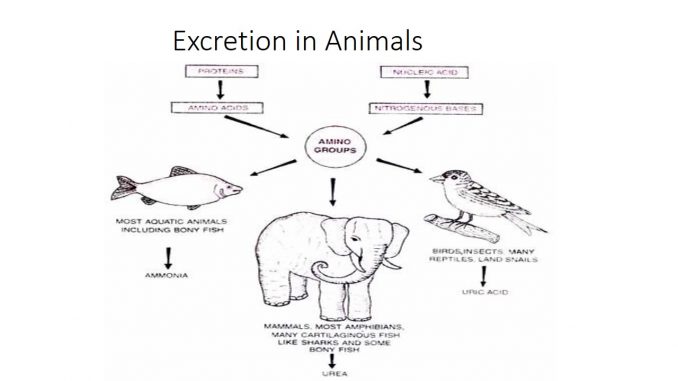
Excretion in Animals; significance of excretion, modes and types of excretory wastes in different animals
Excretion:
- It is defined as elimination of metabolic wastes by an organism at exchange boundries such as plasma membrane of unicellular organisms and or excretory tubules (flame cell, nephridia, malphigean tubules, nephrons etc) of multicellular organisms. Metabolic wastes products are nitrogenous materials (urea), CO2, pigments (bilirubin), excess of water, inorganic salts etc. It differ from egestion (defecation) and secretion
- Osmoregulation: It is the process of maintaining constant osmotic conditions in the body. It mainly involve maintaining constant water and electrolyte (Na, K and Cl ion) concentration.
Significance of excretion:
- Removal of unwanted metabolic byproducts: Metabolism of carbohydrates and fats produces CO2and H2O, similarly Protein metabolism produces nitrogenous wastes in the cell and tissue which are remove by excretion.
- Removal of toxic wastes: accumulation of excretory products such as nitrogenous wastes, CO2, pigments formed by the breakdown of haemoglobin, drugs etc.is harmful to the body. So, these toxic wastes are removed.
- Osmoregulation of the body: it helps maintaining constant ionic concentration of body fluid as well as Regulating water content of the body
- Regulation of body PH
- Thermoregulation: Excretion also helps to maintain a constant body temperature
Modes and types of excretory wastes in different animals
Excretory products and their types
- Metabolism of carbohydrates and fats produces CO2and H2O which are easy to remove. They are effectively removed through lungs (expired air), skin (sweat) or kidneys (urine).
- Other excretory products such as bile pigments (formed by the breakdown of RBCs), drugs etc. are removed in liver.
- Metabolism of proteins produces nitrogenous wastes such as ammonia, which is the basic nitrogenous catabolites of protein, formed by breakdown of amino acids is finally removed from Kidney.
- Depending upon the form in which nitrogenous waste is excreted from the body, the organisms are grouped as under into three categories:
Ammonotelic, Uricotelic and Ureotelic
1. Amminotelic organism
- Those animals which excrete their nitrogenous waste in the form of ammonia are known as ammonotelic.
- Ammonia is highly soluble in water with which it forms ammonium hydroxide (NH4OH) which can damage cells directly by its alkaline caustic action.
- Excretion of ammonia requires large amounts of water, so that more water loss from the body. That is why such a mode is suitable for aquatic organisms which have a constant access to water.
- Ammonia is the first metabolic waste product of protein metabolism and no energy is required to produce ammonia.
- Examples: All aquatic invertebrates, bony fishes and aquatic amphibians are amminotelic organisms.
2. Uricotelic organism
- Those animals which excrete their nitrogenous waste mainly in the form of uric acid and urates are known as uricotelic.
- The phenomenon is known as uricotelism.
- Elimination of uric acid requires lesser amount of water, comparatively less soluble in water and is less toxic as compared to ammonia.
- Examples: All terrestrial animals like insects, reptiles, and birds excrete uric acid as nitrogenious wastes
3. Ureotelic organism
- Those animals that excrete their nitrogenous waste mainly in the form of urea are known as ureotelic and the phenomenon is known as ureotelism.
- Urea can be stored in body for considerable periods of time, and is least toxic. It is eliminated in the form of urine.
- Examples: Ureotelism is exhibited by semi-terrestrial animals, e.g. adult amphibians and mammals
